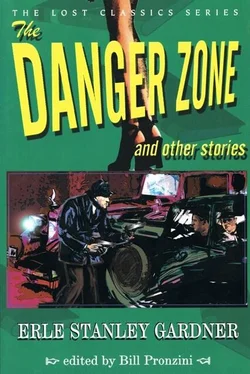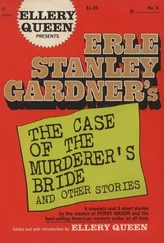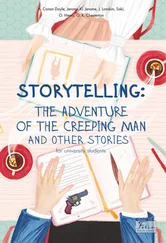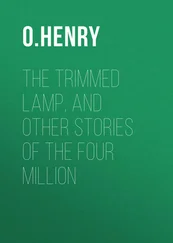Erle Stanley Gardner
The Danger Zone and Other Stories
Introduction
by Bill Pronzini
Erle Stanley Gardner was among the most prolific mystery writers of all time not only in number of published words — close to 20,000,000 — but in the number of series characters he created over the course of his remarkable fifty-year career. Beginning in the early 1920s he gave birth to no less than 49 unique detectives and adventurers who made two or more appearances in book or magazine form, and to dozens of others who might easily have become series characters if editors, readers, and/or Gardner himself had so desired.
Perry Mason, of course, is by far his most celebrated, fertile, and enduring invention; along with Della Street and Paul Drake, Mason appears in 82 of the 128 novels published by Gardner between 1933 and 1970. The amusing detective team of Donald Lam and Bertha Cool are featured in 29 book — length adventures as by A. A. Fair. Crusading district attorney Doug Selby has the starring role in nine, irrepressible and eccentric Gramps Wiggins and San Francisco attorney and former China service diplomat Terry Clane in two each, and criminologist Sidney Griff and advertising executive cum detective Sam Moraine in one each as by Carleton Kendrake and Charles J. Kenny, respectively.
All of Gardner’s other series characters and might-have-beens were created for the magazine markets, both pulp-paper and slick-paper, and appear only in novelettes and short stories. Several hundred of these yams saw print from the 1920s into the 1950s, the preponderance in a ten-year-span from 1926 to 1936 when Gardner lived up to his billing as “King of the Woodpulps” by producing and selling an average of one million words of fiction annually. Argosy, Black Mask, and Detective Fiction Weekly were his favorite pulp markets, printing nearly 200 stories among them. Series tales and one-shots also ran regularly in Dime Detective, Clues, Street & Smiths Detective Story, Top-Notch, Black Aces, All Detective, Short Stories and a host of others. Later, once the Perry Mason novels had begun to achieve widespread popularity, the editors of such slick magazines as The Saturday Evening Post, Country Gentleman, Liberty, American Magazine, Cosmopolitan, and This Week began clamoring for stories, and were obliged with series and prospective series tales. (Gardner even wrote one story on request for the hardboiled digest, Manhunt in 1955 — one of his weaker efforts, in part because it is a straight crime story with no series potential.)
Foremost among his amazing array of short-fiction creations are Ed Jenkins, the Phantom Crook, an outlaw and “famous lone wolf” who lives by his wits and solves crimes unjustly pinned on him by the police, many of which have San Francisco Chinatown settings; and Lester Leith, debonair man-about-town, whose “chain lightning mind” allows him to both outfox criminals and outmaneuver his butler, Scuttle, an undercover police spy. Jenkins appears in 72 novelettes published in Black Mask between 1925 and 1943, several of which were reprinted in two posthumous collections. Leith can be found in 65 novelettes in Detective Fiction Weekly from 1929 to 1943, and in one posthumous collection.
Other series characters with substantial careers include Bob Zane, desert prospector and manhunter, hero of the “Whispering Sands” tales that ran in Argosy in the early 30s; Sidney Zoom, master of disguises, who operates outside the law and serves the intelligence departments of three nations; Señor Arnaz de Lobo, Mexican soldier of fortune and revolutionist; the Patent Leather Kid, a wealthy club man with a secret and sinister sideline; Paul Pry, suave “crime juggler,” who solves baffling cases by concentrating while banging on his collection of drums; Bob Larkin, adventurer-at-large and juggler whose only weapon is a billiard cue; Ken Coming, a brilliant young attorney and embryonic version of Perry Mason; Speed Dash, the Human Fly; Black Barr, a hardbitten Westerner who believes himself to be an instrument of divine justice; the firm of Small, Weston & Burke, detectives who specialize in macabre and horrific cases; and Sheriff Bill Eldon, good-hearted, aging, and shrewd, a pair of whose investigations comprise the 1947 collection, Two Clues.
Some if not all of the above may be familiar to modern readers. Not so the unsung sleuths featured in these pages, none of whom had more than half a dozen outings and several of whom (mores the pity) had only one. Even the most dedicated Gardner aficionado is unlikely to have made a previous acquaintance of:
• Snowy Shane, a tough-minded private eye with a penchant for highly unorthodox detective work.
• Slicker Williams, a felon and ex-convict “so crooked he could hide himself behind a corkscrew,” who utilizes the tricks of his trade to help a damsel in distress and astonishes himself by reforming.
• Major Copely Blane, freelance diplomat and adventurer in international politics, who operates in “diplomatic danger zones.”
• Key-Clew Clark, consulting criminologist and practitioner of the theory that one major clue dominates any given crime and points to the guilty party.
• Bob Crowder, another freelance detective whose stock-in-trade is the unorthodox and unexpected and who delights in thumbing his nose at the police.
• George Brokay, a wealthy, bored young bachelor whose fondest ambition is to put some excitement in his life by becoming a gentleman burglar, and who gets a great deal more than he bargained for when his wish is granted.
• Gilbert E. Best, as hardboiled and unscrupulous a character as any to come from his creator’s typewriter, who is not above such niceties as blackmail and coercion to get results.
• Pete Strickland, big, quiet, philosophical, a deductive-reasoning dick employed by the Manufacturer’s Investigating Bureau, who prefers the principles of common sense to those of psychological profiling.
• Barney Killigen, a somewhat flaky criminal attorney in constant money trouble, whose methods are weirdly unpredictable and who has unfailing faith in the power of classified newspaper ads; and his private secretary, Miss Winifred Ilsa “Wiggy” Graham, the narrator of his cases.
• Pete Wennick, law student, former private detective, and undercover operative for a large, highly ethical law firm that sometimes requires unethical investigative methods to best serve its clients.
• Wyoming rancher Howard Kane and his foreman, Buck Doxey, good Samaritans and amateur detectives who effectively combine wiles, brawn, and specialized rangeland knowledge.
The eleven stories featuring this disparate assemblage of sleuthing talent contain all the qualities that made Gardner a globally bestselling author: unusual situations, ingenious gimmicks and plot twists, and lightning-paced, no-frills prose. Settings range from large cities to small towns, from San Francisco’s Chinatown to a speeding train and the Wyoming grasslands. Some are straight detective tales of various types — ratiocinative, moderately hardboiled, cleverly manipulative. Others feature political intrigue, adventure in the grand pulp manner, rough-and-tumble action, early forensics, points of law and legal trickery. None has been previously collected, nor reprinted in any book or magazine in more than forty years.
Subsequent volumes in this series will showcase the exploits of some of Gardner’s long-running but little known pulp series characters — Sidney Zoom, Senor Lobo, The Patent Leather Kid, and Small, Weston & Burke, among others — as well as uncollected tales starring Ed Jenkins and Lester Leith. The first of these volumes, The Casebook of Sidney Zoom is scheduled for publication by Crippen & Landru in the spring of 2005.
Читать дальше












